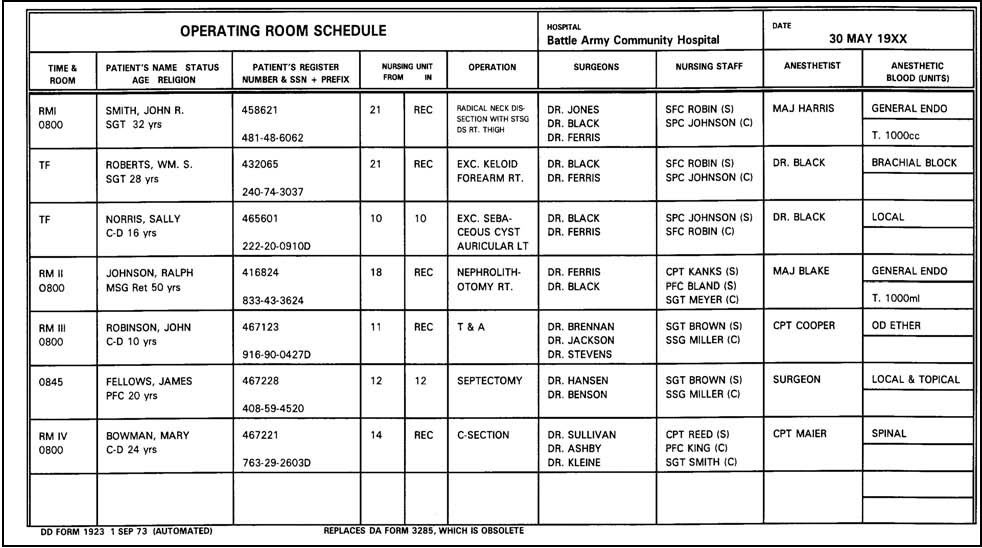Introduction to the Operating Room
LESSON 2: Operating Room Personnel, Policies, and Nomenclature
2-18
2-18. OPERATING ROOM SPECIALIST
a. Discussion. The OR specialist is directly responsible to the NCOIC (see figure 2-1) and to the professional personnel with whom he works. The specialist may be assigned duties directly related to the performance of an operation, as the scrub or as the circulator. He may be assigned to the workroom, the instrument room, the anesthesia section, or to any other area within the surgical suite. Specific tasks, which may be revised in accordance with local policy, involved in the performance of these duties are set forth in b and c below.
b. Scrub Duties. Scrub is the term used to designate the member of the surgical team who assists the surgeon by providing sterile instruments, sutures, and supplies within the sterile field. When assigned as the "scrub," the specialist dons conductive shoes, greens (pants and shirt), cap, and mask. He then scrubs his hands and arms in accordance with local policy; he dons sterile gown and gloves (refer to figures 1-30 and 1-31) and helps other members of the "sterile" team to do so. The scrub arranges the sterile supplies and assumes responsibility for the sterility of the items for use within the operative field both before and during the surgical procedure. His routine tasks are to:
Figure 2-2. Typical nursing services personnel time schedule.
Figure 2-3. Operating Room Schedule.
(1) Check DD Form 1923, OR Schedule.
(2) Perform a surgical scrub.
(3) Put on sterile gown and gloves.
(4) Check internal sterilization indicator controls.
(5) Prepare prep set first.
(6) Separate and arrange sterile basins.
(7) Arrange linen on double-ring stand next to sterile basin.
(8) Drape Mayo stand.
(9) Arrange instruments and sterile supplies on back table and Mayo tray.
(10) Prepare suture material.
(11) Count sponges with circulator (witnessed by registered nurse).
(12) Gown and glove the surgeon.
(13) Assist surgeon with draping.
(14) When ready to begin assisting the surgeon, move Mayo stand into position.
(15) Pass instruments, sponges, supplies, and sutures to surgeon.
(16) Anticipate the surgeon's needs.
(17) Remove loose sponges from operative area as necessary.
(18) Recount sponges with circulator (witnessed by registered nurse).
(19) Assist surgeon with dressing sponges.
(20) Move sterile tables away from operating table.
(21) Remain sterile until patient leaves the room.
(22) Prepare instruments and supplies, used and unused, for clean up.
(23) Remove supplies from room and put in proper place.
(24) Assist circulator in preparing for next operation.
c. Circulating Duties. The circulator is the member of the surgical team who works outside the sterile field, gives patient care, procedures needed supplies, and assists surgical team members in performing the operation safely and expeditiously. He dons conductive shoes, cap, mask, and greens (pants and shirt). The specialist assigned to circulate assembles and brings into the room all packs, supplies, and equipment needed for the case; he ties the gowns for "sterile" members of the team and sets up nonsterile items of equipment; he also performs other nonsterile duties. His routine tasks are to:
(1) Check DD Form 1923, OR Schedule.
(2) Damp dust all equipment and wet-vacuum floor prior to a surgical procedure.
(3) Check mechanical and electrical equipment.
(4) Arrange furniture in functional order.
(5) Assemble, arrange, and open outer and inner wrappers of sterile supplies. Check package integrity, expiration date, and appearance of the indicating tape.
(6) Assist with gowning of scrub and surgeons.
(7) Pour sterile solutions: water, normal saline, and antibacterial solutions; avoid splashing. Figure 1-22 illustrates commercially prepared and hospital prepared irrigating solutions.
(8) Pass knife blades and suture to scrub.
(9) Pass additional sterile supplies to scrub as needed.
(10) Take sponge count with scrub (must be witnessed by a registered nurse). Record on sponge count board.
(11) Assist anesthetist with moving and positioning patient.
(12) Place the restraining strap properly.
(13) Assist surgeon with prep.
(a) Check with anesthetist before touching patient.
(b) Expose area--avoid unnecessary exposure of the patient.
(c) Place linen protectors to absorb excess moisture.
(d) Focus light.
(e) Removes surgeon's gloves after prep.
(f) Replace kick bucket liner.
(g) Move liner containing soiled prep sponges to outer circle of room.
(h) Do not remove sponges, linen, or trash from room.
(14) Assist anesthetist in securing drapes.
(15) Attach suction tubing to machine.
(16) Remain alert to needs of the scrub.
(17) Assist scrub with arrangement of draped furniture.
(18) Position kick buckets for easy access.
(19) Focus light over operative area.
(20) Prepare specimen for laboratory.
(21) Prepare adhesive strips for dressing.
(22) Verify sponge count with scrub (must also be witnessed by Registered Nurse).
(23) Pass dressing sponges to scrub.
(24) Remove and check drapes for instruments and supplies before discarding into hamper.
(25) Assist in moving patient to litter and secure with straps.
(26) Clean the room and prepare for next case.
d. Other Duties. In addition to understanding and performing tasks related to his assignment as the scrub or the circulator for an operation, the OR specialist is required to understand and participate in tasks concerned with preparing the patient for surgery (surgical "prep"), assembling packs for use during surgery, assembling instrument sets, and sterilizing supplies and equipment. The specialist is required to practice personal hygiene measures to prevent the spread of pathogenic organisms; he is also required to demonstrate a high standard of personal ethics, as well as practicing such medical ethics as upholding the patient's right to privacy.
e. Effective Duties. In addition to providing effective care of the patient, the OR specialist is responsible for effective performance with regard to the care, preparation, and maintenance of sterile and nonsterile supplies. He is obliged to continue to learn and progress in skill of performing both the simple and more complex procedures. When in doubt, he should not act but seek advice from the proper source.



